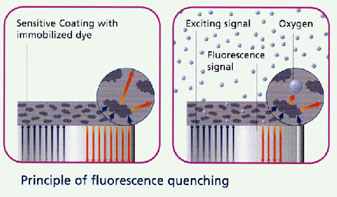Fluorescence Sensor Technology
The principle of fluorescence sensors uses the emission characteristics of specifically sensitive dyes. The dyes' fluorescence behavior depends on the concentration of the analyte towards which they react sensitively. Oxygen is a typical fluorescence quencher. Nowadays, measuring oxygen conentrations is one of the key applications in fluorescence sensor technology.
Principle:
With a specially sensitive dye a fluorescence signal of a specific wavelength can be produced by optical excitation. This emission characteristic depends on the oxygen concentration in the surrounding medium as the dye, when getting in contact with molecular oxygen, transfers parts of the luminescence energy to the oxygen. The more oxygen is contained in the surrounding medium the more luminescence is transferred. Hence, the emission characteristics of the luminescence signal is modified/erased further on.

The relationship between fluorescence intensity and the fluorescence decay time during the oxygen absence (Io,to) and the oxygen [pO2] presence (I,t) is given by the Stern-Volmer equation:
Io/I = to/t = 1 + KSV [pO2]
